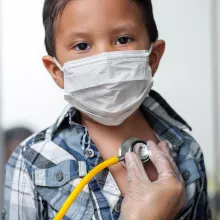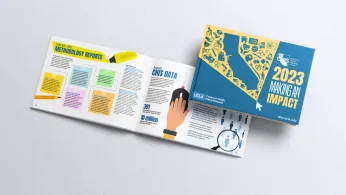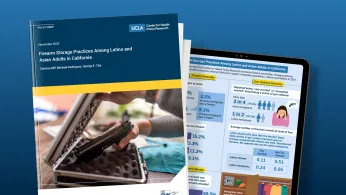Publications Menu
The 2023 California Health Interview Survey (CHIS) Making an Impact report highlights the exciting work produced by CHIS this year — from brand new data to research, publications, events, and more.
The 2023 California Health Interview Survey (CHIS) Making an Impact report highlights the exciting work produced by CHIS this year — from brand new data to research, publications, events, and more.
Data collection is critical to the development of sound policies and programs, particularly on issues related to sexual orientation, gender identity, gender expression, and sex characteristics (SOGIESC).
Data collection is critical to the development of sound policies and programs, particularly on issues related to sexual orientation, gender identity, gender expression, and sex characteristics (SOGIESC).
Authors aim to assess the accuracy of GPT-4, the conversational artificial intelligence, in the diagnosis and triage of health conditions and whether its performance varies by patient race and ethnicity.
Authors aim to assess the accuracy of GPT-4, the conversational artificial intelligence, in the diagnosis and triage of health conditions and whether its performance varies by patient race and ethnicity.
Authors identified COVID-19-related health and social disparities among U.S. immigrants. Using data from the 2021 CHIS, they analyzed predictors of COVID-19-related health and social outcomes during the pandemic by citizenship status.
Authors identified COVID-19-related health and social disparities among U.S. immigrants. Using data from the 2021 CHIS, they analyzed predictors of COVID-19-related health and social outcomes during the pandemic by citizenship status.
Authors examine the demographic, socioeconomic, and health characteristics of Asian non-citizen LGBT immigrants. Authors focused on noncitizens, including both those who are authorized to be in the United States and those who are unauthorized, because they are a group at heightened vulnerability to low socioeconomic status and poor health.
Authors examine the demographic, socioeconomic, and health characteristics of Asian non-citizen LGBT immigrants. Authors focused on noncitizens, including both those who are authorized to be in the United States and those who are unauthorized, because they are a group at heightened vulnerability to low socioeconomic status and poor health.
Latino and Asian immigrants represent the two largest immigrant populations in California, yet little is known about firearm ownership and storage practices among individuals in these groups. This policy brief explores firearm ownership and storage practices among Latino and Asian adults in California using the 2021 California Health Interview Survey (CHIS).
Latino and Asian immigrants represent the two largest immigrant populations in California, yet little is known about firearm ownership and storage practices among individuals in these groups. This policy brief explores firearm ownership and storage practices among Latino and Asian adults in California using the 2021 California Health Interview Survey (CHIS).
This study describes a computer-mediated peer support program that centers around sharing circles: spaces for personal, narrative storytelling to encourage home care workers (HCWs) to collaboratively reflect on their home care experiences and build rapport with their peers. Authors describe program design and a 12-week deployment to evaluate the program with 42 HCWs in New York City.
This study describes a computer-mediated peer support program that centers around sharing circles: spaces for personal, narrative storytelling to encourage home care workers (HCWs) to collaboratively reflect on their home care experiences and build rapport with their peers. Authors describe program design and a 12-week deployment to evaluate the program with 42 HCWs in New York City.
Researchers determine whether patient-surgeon gender concordance is associated with mortality of patients after surgery in the United States. Study participants were 100% Medicare fee-for-service beneficiaries aged 65 to 99 years who had one of 14 major elective or non-elective (emergent or urgent) surgeries in 2016 to 2019.
Researchers determine whether patient-surgeon gender concordance is associated with mortality of patients after surgery in the United States. Study participants were 100% Medicare fee-for-service beneficiaries aged 65 to 99 years who had one of 14 major elective or non-elective (emergent or urgent) surgeries in 2016 to 2019.
The authors argue that the mental health of children represents one of the most important areas for investments that we can make as a society. They explain how and why we are currently failing to make the best investments in this area; outline opportunities to improve how we address children's mental health through policies, programs, and practices; and recommend how practitioners, child-serving organizations, policymakers, and other stakeholders can promote such investments.
The authors argue that the mental health of children represents one of the most important areas for investments that we can make as a society. They explain how and why we are currently failing to make the best investments in this area; outline opportunities to improve how we address children's mental health through policies, programs, and practices; and recommend how practitioners, child-serving organizations, policymakers, and other stakeholders can promote such investments.
Researchers assess trends in food insecurity between 2005 and 2017 — a period including the Great Recession — by participation in the Special Supplemental Nutrition Program for Women, Infants and Children (WIC).
Researchers assess trends in food insecurity between 2005 and 2017 — a period including the Great Recession — by participation in the Special Supplemental Nutrition Program for Women, Infants and Children (WIC).
















